Where you see this button
Spider Collector's Journal (19th page: 2009) Copyright © 2009 by Rod Crawford
Here's the 19th page of narratives of fun (and not so fun)
trips to collect spiders for research at the Burke
Museum, often accompanied by capable field volunteer Laurel Ramseyer. Most also appeared in Scarabogram, newsletter of "Scarabs:
The Bug Society." Dates of field trips head each paragraph. Maps showing
the location of sites within Washington state follow the grid system outlined
in the Washington
Spider Checklist. RETURN
TO INDEX
Where you see this button ![]() in a
field trip account, click it to get a page of collecting site photos! Note, I'm
experimenting this year with larger photos — if you have a slow connection, let me know how it's working.
in a
field trip account, click it to get a page of collecting site photos! Note, I'm
experimenting this year with larger photos — if you have a slow connection, let me know how it's working.
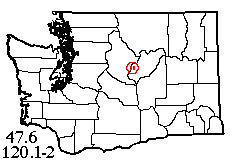 |
![]() 1 V 2009: Way back in 1974, I'd spent a day in two canyons on the west border of Douglas County and come away with just 7 and 10 species respectively. Hoping to do better and complete both samples, Laurel and I set out to do the long drive and ambitious project in just one day, aided by 35 more years of collecting experience and pre-selection of localities with online resources. First stop was a cottonwood grove on a little peninsula of county land between a farm and a vacation home on Lake Entiat (formerly the Columbia River) at the edge of a community called Orondo. This tiny area was rich in spider habitat, with abundant cottonwood litter; a grassy riparian meadow around the edge of the grove; stony and sandy shorelines; and a cattail marsh. Specimens weren't abundant but we took 18 species in about 3 hours, including the uncommon jumping spider Sitticus sylvestris. Then on to a sagebrush habitat one mile up Corbaley Canyon where 4 more species were added in under an hour. With the old records, that brought the Corbaley sample up to 28 species, even though an extremely active male Habronattus jumped into my net twice, then out again in a split second and vanished (curses!).
1 V 2009: Way back in 1974, I'd spent a day in two canyons on the west border of Douglas County and come away with just 7 and 10 species respectively. Hoping to do better and complete both samples, Laurel and I set out to do the long drive and ambitious project in just one day, aided by 35 more years of collecting experience and pre-selection of localities with online resources. First stop was a cottonwood grove on a little peninsula of county land between a farm and a vacation home on Lake Entiat (formerly the Columbia River) at the edge of a community called Orondo. This tiny area was rich in spider habitat, with abundant cottonwood litter; a grassy riparian meadow around the edge of the grove; stony and sandy shorelines; and a cattail marsh. Specimens weren't abundant but we took 18 species in about 3 hours, including the uncommon jumping spider Sitticus sylvestris. Then on to a sagebrush habitat one mile up Corbaley Canyon where 4 more species were added in under an hour. With the old records, that brought the Corbaley sample up to 28 species, even though an extremely active male Habronattus jumped into my net twice, then out again in a split second and vanished (curses!).
![]() Our last stop (again on county land) was in the bottom of Pine Canyon (higher and farther east) where the old sample gave us a 10-species head start. Most habitats here had extremely sparse spider faunas. Even Laurel's favorite technique of tapping specimens out of pine cones produced only Euryopis, Phocophora and one Xysticus. The one really productive spot was a side ravine, rather densely wooded with Douglas-fir and aspen, with practically a spider under every rock. Here I got the rare Drassyllus dromeus and a further range extension for the coastal Calymmaria emertoni, among others. In the end we successfully brought the species total up to 23. The terrain was beautiful, the new camera (amazingly complicated) worked fine, and native plants dominated the flora, so we enjoyed hunting for the relatively few spiders. I'd hoped to revisit an old favorite hamburger joint in Wenatchee (Vic's) but it was gone; however, the relatively new EZ's Deluxe Burgers made a delicious replacement. We each found one tick afterward – Laurel's was female, and mine male!
Our last stop (again on county land) was in the bottom of Pine Canyon (higher and farther east) where the old sample gave us a 10-species head start. Most habitats here had extremely sparse spider faunas. Even Laurel's favorite technique of tapping specimens out of pine cones produced only Euryopis, Phocophora and one Xysticus. The one really productive spot was a side ravine, rather densely wooded with Douglas-fir and aspen, with practically a spider under every rock. Here I got the rare Drassyllus dromeus and a further range extension for the coastal Calymmaria emertoni, among others. In the end we successfully brought the species total up to 23. The terrain was beautiful, the new camera (amazingly complicated) worked fine, and native plants dominated the flora, so we enjoyed hunting for the relatively few spiders. I'd hoped to revisit an old favorite hamburger joint in Wenatchee (Vic's) but it was gone; however, the relatively new EZ's Deluxe Burgers made a delicious replacement. We each found one tick afterward – Laurel's was female, and mine male!
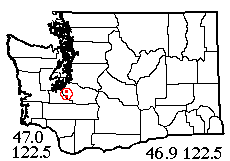 |
![]() 16 V 2009: The quasi-annual Pierce County BioBlitz took place in the area south of Roy (home of the Roy Rodeo) this year. As with any such event, the object is to document biodiversity by recording as many species of living things as possible in a set time period. Saturday morning, Laurel and I arrived at headquarters, partook of free food, picked up our Nature Tracker (Laura Langer) and her volunteer father, and consulted with coordinator Krystal Kyer to find a primary survey site north of the 47.0 degree line, where I really needed a sample. Krystal came through and we were off to a tract of grassland (former pasture) a half mile west of Roy. Laurel and Laura swept while I sifted maple litter and beat conifers, then did some sweeping of my own in a small marsh (northern outlier of Denton Marsh). Some spiders were taken from a lodgepole pine tree that might be indigenous to the site, though uncommon west of the Cascades. The BioBlitz herpetologists contributed a semiaquatic wolf spider Pirata piraticus from their salamander trap. The rarest spider taken here was a Misumenops beaten by Laurel from snowberry, unfortunately preserved immature. The total for the site, 43 species of which 37 were positively identifiable "keepers."
16 V 2009: The quasi-annual Pierce County BioBlitz took place in the area south of Roy (home of the Roy Rodeo) this year. As with any such event, the object is to document biodiversity by recording as many species of living things as possible in a set time period. Saturday morning, Laurel and I arrived at headquarters, partook of free food, picked up our Nature Tracker (Laura Langer) and her volunteer father, and consulted with coordinator Krystal Kyer to find a primary survey site north of the 47.0 degree line, where I really needed a sample. Krystal came through and we were off to a tract of grassland (former pasture) a half mile west of Roy. Laurel and Laura swept while I sifted maple litter and beat conifers, then did some sweeping of my own in a small marsh (northern outlier of Denton Marsh). Some spiders were taken from a lodgepole pine tree that might be indigenous to the site, though uncommon west of the Cascades. The BioBlitz herpetologists contributed a semiaquatic wolf spider Pirata piraticus from their salamander trap. The rarest spider taken here was a Misumenops beaten by Laurel from snowberry, unfortunately preserved immature. The total for the site, 43 species of which 37 were positively identifiable "keepers."
Having got the new sample I came for, the next order of the day was to add to the BioBlitz total by visiting new habitats farther south (in the same area as our highly productive Centralia Canal trip of 2007). First was a tract of gravelly prairie a mile south of Roy called the "gopher set-aside," saved from a surrounding housing tract to protect a rare pocket gopher. We saw no gophers but this prairie would be pretty high-quality habitat if not for the Scots broom, which really ought to be dealt with. There are 2 subsections east and west of the railroad tracks, which were way too clean (I'd hoped to find habitat in the usual trackside junk). Laurel took the east and I the west side of the tracks. Spiders were good in the field vegetation, including a rare prairie-endemic Metepeira, but the prize was Laurel's female of the ant-mimic jumping spider Synageles occidentalis, taken in Washington only once before (see album; the previous specimen, from Yakima Canyon, is at Harvard). Nine spider species from here (7 identifiable) added to the previous site's total for Blitz purposes.
Our last stop (on county land) was 2.8 miles south of Roy in a coniferous forest tract west of the highway, with a rich understory flora and containing a surprising hidden alder swamp. I sifted moss and litter on the slope leading down to the swamp, and both Laurel and I swept the understory and searched dead wood habitats. Most species taken here were new to the Blitz list, including a rare undescribed Linyphantes, a hard-to-come-by male of the minute Trogloneta, and two different Ethopolys centipede species. In all we recorded 70 spiders and 16 non-spiders for the BioBlitz, and nothing went wrong all day!
 |
![]() 18 V 2009: In late July 1976, my late father and I (on one of our few collecting trips together) visited an area that intrigued me because of its isolation: an outlying bit of Gifford Pinchot National Forest far NW of the rest, in a nameless range of hills separated from the Cascades by deep valleys, containing the headwaters of the little-visited Little Nisqually River. A maze of logging roads brought us to the dirty secret of this little area: the higher central portions were all one vast clearcut that went on for miles and miles! We found some proper forest remaining in the river valley but due to my inexperience and the late season, I got only 5 species there. Now move forward in time 33 years. In my continuing project to supplement old inadequate samples, I'd identified current access to the same area via Pleasant Valley Road, which becomes Forest Road 74, along the south side of Alder Reservoir, shown on all current maps and online photos. This was to be the year's first trip in a rented Zipcar with my friend and volunteer Della Scott.
18 V 2009: In late July 1976, my late father and I (on one of our few collecting trips together) visited an area that intrigued me because of its isolation: an outlying bit of Gifford Pinchot National Forest far NW of the rest, in a nameless range of hills separated from the Cascades by deep valleys, containing the headwaters of the little-visited Little Nisqually River. A maze of logging roads brought us to the dirty secret of this little area: the higher central portions were all one vast clearcut that went on for miles and miles! We found some proper forest remaining in the river valley but due to my inexperience and the late season, I got only 5 species there. Now move forward in time 33 years. In my continuing project to supplement old inadequate samples, I'd identified current access to the same area via Pleasant Valley Road, which becomes Forest Road 74, along the south side of Alder Reservoir, shown on all current maps and online photos. This was to be the year's first trip in a rented Zipcar with my friend and volunteer Della Scott.
Well, Pleasant Valley (should be called dandelion valley) Road was pleasant enough, but 60 meters into public land, what should we meet but a locked gate! We'd just seen a sign that the road would be closed after Memorial Day but that was still a week away. I finally decided that I wanted this resample badly enough to walk 2-3 miles on a level, paved road; weather was delightful and Della the good sport was willing to amuse herself for the necessary hours. I'm off! But what's this? Water over the road, then a major washout occupied by a large log jam, then an even bigger washout and huger log pile to negotiate. After this point the road, clearly abandoned years ago (a fact unknown to mapmakers), though originally paved, was quickly returning to nature with numerous downed trees, drifts of leaves, moss, and a few plants growing on the pavement. Not such an easy walk; I now calculate that I trudged 3.1 miles of this before reaching my goal, a grassy log landing overlooking a large wetland. A deer trail marked by debris from hunters (probably the only other humans to visit the spot since it was logged) led to the marsh 120 feet below, ringed by the "logging" activity of beavers. Nothing wrong with the spot: splendidly isolated, beautiful and reasonably rich in spiders. The marsh grass produced 12 species; 3 wolf spider and 2 jumping spider species were moving about; the salal, fern and Oregon grape yielded several additions, some uncommon; more species were on the conifer foliage (different ones by the marsh and the clearing above). Much of the marsh was impounded by one of the most ambitious beaver dams I've ever seen. The beavers weren't happy about my inspecting it, and kept making huge splashes on the other side. I also saw bear scat, heard plenty of chorus frogs, and found two garter snakes sharing their homes under rocks with ant colonies! Feeling it was probably time to head back, I looked at my watch to discover I had 11 minutes to walk 3 miles of erstwhile road before my rendezvous time with Della expired. I did say she was a good sport, didn't I? Well, this time she needed to be. The weather was closing in, but it didn't start to rain until the moment we were both in the car ready to go. All in all, not bad, and I added over 30 species to the original total of 5! But hey guys, there's really no Forest Road 74 there!
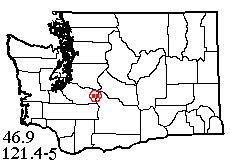 |
![]() 28 V 2009: On the spur of the moment, I concocted a plan to collect near Silver Creek Ranger Station just outside the Greenwater River entrance of Mt. Rainier National Park. Collections by others had given me a "head start" of 7 species for the area. We'd had such good results last year collecting at a ranger station that Laurel and I made our first stop the historic Silver Creek Guard Station building, established 1919 and rebuilt in 1930 following a fire. The exterior of this 79-year-old log cabin had many nooks and crannies for spider habitat. Relatively modern buildings in the complex had many old signs and boards leaning against them, making even better spider habitat. The buildings and wood piles produced 16 species! Not knowing I already had my sample, I wanted some vegetation spiders too. And Google Earth showed a nearby green clearing that I assumed was a meadow. Would you believe it – a parking lot! There must have a been a green filter on the camera that day. However, mature forest surrounded the lot and I added 9 species to the list from conifer foliage and one more from the sparse spiders on salal, while Laurel found some good dead wood habitat that yielded an adult Microhexura (see album) among others.
28 V 2009: On the spur of the moment, I concocted a plan to collect near Silver Creek Ranger Station just outside the Greenwater River entrance of Mt. Rainier National Park. Collections by others had given me a "head start" of 7 species for the area. We'd had such good results last year collecting at a ranger station that Laurel and I made our first stop the historic Silver Creek Guard Station building, established 1919 and rebuilt in 1930 following a fire. The exterior of this 79-year-old log cabin had many nooks and crannies for spider habitat. Relatively modern buildings in the complex had many old signs and boards leaning against them, making even better spider habitat. The buildings and wood piles produced 16 species! Not knowing I already had my sample, I wanted some vegetation spiders too. And Google Earth showed a nearby green clearing that I assumed was a meadow. Would you believe it – a parking lot! There must have a been a green filter on the camera that day. However, mature forest surrounded the lot and I added 9 species to the list from conifer foliage and one more from the sparse spiders on salal, while Laurel found some good dead wood habitat that yielded an adult Microhexura (see album) among others.
Sure of the "6915" sample now, I wanted to visit a higher elevation site in adjacent "6914" across Silver Creek from the road to Crystal Mountain ski area. What appeared to be a nice meadow on aerial photos was largely snow-covered, so we headed north (downstream) along our side road, partly on foot, and collected at an attractive spot at 3560 feet where a small tributary rushed down toward Silver Creek, with thickets of slide alder and vine maple, neither one yet in leaf, and salmonberry just coming into bloom. I expected Pardosa to be active on the roadside rocky slopes, but saw nary a one. The alder litter had a few good spiders but there wasn't much litter there. The vine maple litter added nothing, so I kept beating the ever-reliable conifer foliage until I had at least 10 species from that habitat (13 as it turned out, with 2 more added by Laurel). Laurel found Robertus under a rock and Metellina mimetoides (among others) in aerial webs, then got tired and went to rest in the car. Meanwhile, the local Pardosa population very uncharacteristically became active as soon as the sun was off their habitat. I took several of these and a few spiders from logs in the woods (including one microspider I haven't recognized yet) and called it a day. Our total for this area was 25 species, not a brilliant collection but a pleasant and successful day.
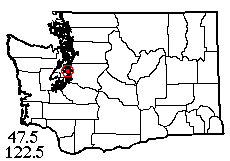 |
![]() 8 VI 2009: An anticipated car trip was postponed, so I used the free day for local collecting on public transportation: by bus to Fauntleroy, by ferry to Southworth on the SE shore of the Kitsap Peninsula, then by foot (the most public transportation of all) a mile due west to what appeared to be an unused public right of way. I was hoping for access to the wild south fringes of Harper County Park but that route petered out in blackberries. But the right-of-way took a left turn into a blackberry-free tall grass field that produced 8 species, including Clubiona kastoni and Pardosa moesta. Next, I returned to the pleasantly low-traffic highway for access to the main part of the park, and approaching it I glimpsed an intriguing wetland through the roadside trees. It was a tidal marsh separated from Colby Bay by a road (presumably with a culvert to let the tide through), little-visited and in nice condition. Sweeping the marsh grass and sedge I got many seemingly good spider specimens, but alas, most were either super-common or juvenile. There was one good tideland species there though, Sitticus palustris; litter and moss at the marsh edge produced several more (common) species. Next, on to Colby Bay (its east shore belonging to the park), within a couple of miles of where my father spent his grade-school days in the early 1920s. Dad used to tell stories of his bumming around in a rowboat with his pal Dexter, no doubt including visits to this very bay (then the site of a now-vanished brickyard, accounting for many deposits of old bricks around the bay). Nobody was on the beach on this beautiful day, and I followed the strand out to the bay mouth seeking jumping spiders on the gravel, driftwood and seawall, but finding none. However, shrubs including wild rose hanging over the beach made 5 useful additions to the day's spider list. I made it back to the road one jump ahead of the tide. Then, on to the park's sports and picnic area to collect house spiders from buildings, but with little success. So, on up a nice trail into the forested part of the park for understory fauna. Invasive ivy had taken over the lower parts of the woods, but on a hilltop crossed by a private road was some native flora hanging down the banks with 8 more spider species. Finally I sampled conifer foliage along the highway (the more natural areas had mostly maple forest), with 4 spider species and a cool protolophid harvestman. My return to the dock was perfectly timed to catch a ferry, and the hazy evening sun made a dazzle on the water; the sun's disc turned solid red while still well above the horizon. Not a lot of unusual species for the day, but 30 total for an unsampled area made it worthwhile.
8 VI 2009: An anticipated car trip was postponed, so I used the free day for local collecting on public transportation: by bus to Fauntleroy, by ferry to Southworth on the SE shore of the Kitsap Peninsula, then by foot (the most public transportation of all) a mile due west to what appeared to be an unused public right of way. I was hoping for access to the wild south fringes of Harper County Park but that route petered out in blackberries. But the right-of-way took a left turn into a blackberry-free tall grass field that produced 8 species, including Clubiona kastoni and Pardosa moesta. Next, I returned to the pleasantly low-traffic highway for access to the main part of the park, and approaching it I glimpsed an intriguing wetland through the roadside trees. It was a tidal marsh separated from Colby Bay by a road (presumably with a culvert to let the tide through), little-visited and in nice condition. Sweeping the marsh grass and sedge I got many seemingly good spider specimens, but alas, most were either super-common or juvenile. There was one good tideland species there though, Sitticus palustris; litter and moss at the marsh edge produced several more (common) species. Next, on to Colby Bay (its east shore belonging to the park), within a couple of miles of where my father spent his grade-school days in the early 1920s. Dad used to tell stories of his bumming around in a rowboat with his pal Dexter, no doubt including visits to this very bay (then the site of a now-vanished brickyard, accounting for many deposits of old bricks around the bay). Nobody was on the beach on this beautiful day, and I followed the strand out to the bay mouth seeking jumping spiders on the gravel, driftwood and seawall, but finding none. However, shrubs including wild rose hanging over the beach made 5 useful additions to the day's spider list. I made it back to the road one jump ahead of the tide. Then, on to the park's sports and picnic area to collect house spiders from buildings, but with little success. So, on up a nice trail into the forested part of the park for understory fauna. Invasive ivy had taken over the lower parts of the woods, but on a hilltop crossed by a private road was some native flora hanging down the banks with 8 more spider species. Finally I sampled conifer foliage along the highway (the more natural areas had mostly maple forest), with 4 spider species and a cool protolophid harvestman. My return to the dock was perfectly timed to catch a ferry, and the hazy evening sun made a dazzle on the water; the sun's disc turned solid red while still well above the horizon. Not a lot of unusual species for the day, but 30 total for an unsampled area made it worthwhile.
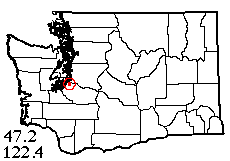 |
![]() 12 VI 2009: Using a just-discovered bus route, I made an afternoon trip to supplement my pitiful 3-species sample from the city of Tacoma, walking across the county line from a remote corner of Federal Way. It should have been about a mile walk, but alas, I didn't know which streets – many! – didn't go through, and the local city planners must have run out of Dead End signs … However, I reached my preselected sites in the Norpoint area (built up in the last 15 years) NW of Tacoma with over 3 hours of daylight left. One site was a "no man's land" sandwiched between a group of residential lots. But as I should have predicted, impenetrable walls of invasive blackberry prevented entry. Nearby was some property owned by the Parks Department which, unknown even to Google Earth, was part of a named park (Norpoint Park of course) which is still mainly on the drawing board. I had a little trouble finding entry points to this stretch also, but managed it near the north edge of the "7224" gridspace. I found myself in an alder-cottonwood forest with a few madrona trees, only partly overrun by blackberry. My first foliage beat sample had no spiders at all, and the outlook for a good sample seemed dim, but a devious route led me to an area with native salal and salmonberry understory, which did produce several species (and even some ripe berries). Leaf litter, when I finally found some, gave me more species. With the sun getting low, I moved 70 meters south to a recently built skate park, and lo, the far end of the pavement opened on a largely natural grassy field (surrounded by blackberry of course) where sweeping gave me 9 more spider species. I tried beating a lone pine tree (which had only some juvenile Zygiella) and with the last daylight tried beating a patch of unshaded roadside salal I'd noted earlier at one of those impenetrable points, adding 2 more species. Leaving, I saw a young rabbit in the grassy field. I came away with 22 species (25 with the old records), retrieving success from the jaws of failure; 10 (40%) were non-native, but there were some interesting and useful records.
12 VI 2009: Using a just-discovered bus route, I made an afternoon trip to supplement my pitiful 3-species sample from the city of Tacoma, walking across the county line from a remote corner of Federal Way. It should have been about a mile walk, but alas, I didn't know which streets – many! – didn't go through, and the local city planners must have run out of Dead End signs … However, I reached my preselected sites in the Norpoint area (built up in the last 15 years) NW of Tacoma with over 3 hours of daylight left. One site was a "no man's land" sandwiched between a group of residential lots. But as I should have predicted, impenetrable walls of invasive blackberry prevented entry. Nearby was some property owned by the Parks Department which, unknown even to Google Earth, was part of a named park (Norpoint Park of course) which is still mainly on the drawing board. I had a little trouble finding entry points to this stretch also, but managed it near the north edge of the "7224" gridspace. I found myself in an alder-cottonwood forest with a few madrona trees, only partly overrun by blackberry. My first foliage beat sample had no spiders at all, and the outlook for a good sample seemed dim, but a devious route led me to an area with native salal and salmonberry understory, which did produce several species (and even some ripe berries). Leaf litter, when I finally found some, gave me more species. With the sun getting low, I moved 70 meters south to a recently built skate park, and lo, the far end of the pavement opened on a largely natural grassy field (surrounded by blackberry of course) where sweeping gave me 9 more spider species. I tried beating a lone pine tree (which had only some juvenile Zygiella) and with the last daylight tried beating a patch of unshaded roadside salal I'd noted earlier at one of those impenetrable points, adding 2 more species. Leaving, I saw a young rabbit in the grassy field. I came away with 22 species (25 with the old records), retrieving success from the jaws of failure; 10 (40%) were non-native, but there were some interesting and useful records.
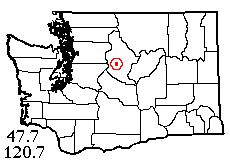 |
![]() 20 VI 2009: The year's second Zipcar trip with Della (specially scheduled to permit Jerry Austin, absent from these trips since 2005, to come along) was planned for a foothill site near Darrington. But suboptimal weather sent us packing across Stevens Pass to a backup site along semi-abandoned Merritt-Winton Road. It was sunny and dry there but windy, which may have influenced the spiders; in any case very few were sweepable or active. I tried Laurel's pine cone technique but got no spiders (she must have a secret twist to knock them out of the cones), and a few hours' work plus 2 species added by Jerry found me with only 12 records. I was even puzzled as to what to name the site (even the mountain it's on is nameless) until I noticed one of those named sidings along the tracks: West Winton. Well, let's try a second site: it looked like there was an accessible stream ravine just south of the town of Winton a few miles away. But between the stream and the road was a pine forest with vine maple understory that was nearly quite impenetrable. The vine maple – pine litter had a few spiders but only Callobius nevadensis was mature; I kept a couple of penultimate male Agelenopsis to rear. Giving up on the vine maple jungle, we had time for one more site. The old topo map showed a small campground, since abandoned, along the secondary highway north of Coles Corner that looked promising. Turns out, it was abandoned because Nason Creek (bigger than some rivers) eroded it away! But the remaining fringe of cottonwoods had some litter (contaminated with mud from the spring floods) with usable spider specimens, though not many. Seven species were added here, and a penultimate Agroeca kept to rear. The Coles Corner store building didn't even have any house spiders on it. A low-grade sample had to be upgraded by live rearing (Agelenopsis utahana and Agroeca pratensis, both good records, successfully matured in the lab). But certainly a pleasant outing, especially with Della's mouthwatering picnic lunch.
20 VI 2009: The year's second Zipcar trip with Della (specially scheduled to permit Jerry Austin, absent from these trips since 2005, to come along) was planned for a foothill site near Darrington. But suboptimal weather sent us packing across Stevens Pass to a backup site along semi-abandoned Merritt-Winton Road. It was sunny and dry there but windy, which may have influenced the spiders; in any case very few were sweepable or active. I tried Laurel's pine cone technique but got no spiders (she must have a secret twist to knock them out of the cones), and a few hours' work plus 2 species added by Jerry found me with only 12 records. I was even puzzled as to what to name the site (even the mountain it's on is nameless) until I noticed one of those named sidings along the tracks: West Winton. Well, let's try a second site: it looked like there was an accessible stream ravine just south of the town of Winton a few miles away. But between the stream and the road was a pine forest with vine maple understory that was nearly quite impenetrable. The vine maple – pine litter had a few spiders but only Callobius nevadensis was mature; I kept a couple of penultimate male Agelenopsis to rear. Giving up on the vine maple jungle, we had time for one more site. The old topo map showed a small campground, since abandoned, along the secondary highway north of Coles Corner that looked promising. Turns out, it was abandoned because Nason Creek (bigger than some rivers) eroded it away! But the remaining fringe of cottonwoods had some litter (contaminated with mud from the spring floods) with usable spider specimens, though not many. Seven species were added here, and a penultimate Agroeca kept to rear. The Coles Corner store building didn't even have any house spiders on it. A low-grade sample had to be upgraded by live rearing (Agelenopsis utahana and Agroeca pratensis, both good records, successfully matured in the lab). But certainly a pleasant outing, especially with Della's mouthwatering picnic lunch.
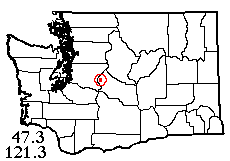 |
![]() 1 VII 2009: Laurel had been on Icicle Creek the week before, and found the rapidly advancing season had dried out the lowland spiders, so we selected a subalpine site for today's trip: Rock Rabbit Lakes (named for the pikas that inhabit boulder talus), reached by an intricate network of forest roads NE of Snoqualmie Pass, which we navigated with ease (and luck). Road conditions made it prudent to hike the last one and a third miles, with a 700 foot elevation gain, just right for the season's first mountain hike. Laurel found the lake before I did: quite a beautiful spot except for the mosquitos, with true fir and mountain hemlock forest, alder thickets, meadows, talus, and remarkably clear water. The forest had been partially logged, and litter was pretty dry, but lengthy sifting produced 3 species including one rarity belonging to an undescribed genus. Laurel had better luck, getting several good species from conifer and elderberry foliage (the ubiquitous huckleberry bushes provided both of us with exactly zero spiders!) and, active on the shore, one jumping spider (Sitticus) and one wolf spider, Arctosa alpigena. I spent some time turning rocks at the edge of the boulder talus, getting Orodrassus canadensis and Lepthyphantes pollicaris. Laurel was able to indulge her fondness for pine cone collecting at one isolated white pine tree, adding 2 spider species. We both found several more species in the seral forest habitat along the logging road above the lake. It was hard work, and I've certainly seen more productive mountain sites, but in the end we added 26 species for a total of 30 from the area. We both agreed that after a warm mountain hike, there's nothing like a visit to Mountain High Hamburgers in Easton. Laurel heard some characteristic squeaks from the talus, but we never did see that wascally wock wabbit.
1 VII 2009: Laurel had been on Icicle Creek the week before, and found the rapidly advancing season had dried out the lowland spiders, so we selected a subalpine site for today's trip: Rock Rabbit Lakes (named for the pikas that inhabit boulder talus), reached by an intricate network of forest roads NE of Snoqualmie Pass, which we navigated with ease (and luck). Road conditions made it prudent to hike the last one and a third miles, with a 700 foot elevation gain, just right for the season's first mountain hike. Laurel found the lake before I did: quite a beautiful spot except for the mosquitos, with true fir and mountain hemlock forest, alder thickets, meadows, talus, and remarkably clear water. The forest had been partially logged, and litter was pretty dry, but lengthy sifting produced 3 species including one rarity belonging to an undescribed genus. Laurel had better luck, getting several good species from conifer and elderberry foliage (the ubiquitous huckleberry bushes provided both of us with exactly zero spiders!) and, active on the shore, one jumping spider (Sitticus) and one wolf spider, Arctosa alpigena. I spent some time turning rocks at the edge of the boulder talus, getting Orodrassus canadensis and Lepthyphantes pollicaris. Laurel was able to indulge her fondness for pine cone collecting at one isolated white pine tree, adding 2 spider species. We both found several more species in the seral forest habitat along the logging road above the lake. It was hard work, and I've certainly seen more productive mountain sites, but in the end we added 26 species for a total of 30 from the area. We both agreed that after a warm mountain hike, there's nothing like a visit to Mountain High Hamburgers in Easton. Laurel heard some characteristic squeaks from the talus, but we never did see that wascally wock wabbit.
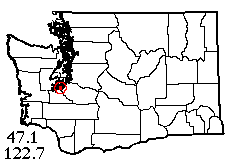 |
![]() 9 VII 2009: We'd planned another mountain hike. But rain and thunderstorms threatened in the mountains, so heigh ho for the lowlands, out toward the coast where things weren't quite dry yet. We got almost as far as Olympia to discover that neither Laurel nor I had anything to buy gasoline with! Fortunately there was an unsampled gridspace just north of us, on a peninsula jutting into the south end of Puget Sound. With no maps but the state atlas, we tried two public boat launch sites but found too little accessible habitat at either. Proceeding on down the coast with one eye on the gas gauge, we came to the dead end of Sandy Point Road and lo, a tiny parking lot at an obviously public (but unidentified) trailhead. Saved!
9 VII 2009: We'd planned another mountain hike. But rain and thunderstorms threatened in the mountains, so heigh ho for the lowlands, out toward the coast where things weren't quite dry yet. We got almost as far as Olympia to discover that neither Laurel nor I had anything to buy gasoline with! Fortunately there was an unsampled gridspace just north of us, on a peninsula jutting into the south end of Puget Sound. With no maps but the state atlas, we tried two public boat launch sites but found too little accessible habitat at either. Proceeding on down the coast with one eye on the gas gauge, we came to the dead end of Sandy Point Road and lo, a tiny parking lot at an obviously public (but unidentified) trailhead. Saved!
Things began well when we swept 10 species from the little roadside verge area at the trailhead, including a new county record for recently introduced Entelecara congener. Laurel took one fork and sampled understory and conifer foliage, while I took the other, left the trail and sifted alder litter, moss and maple litter, getting respectively 2, 2, and 5 spider species – all different though – and swept additional common understory spiders. We both ended up (at different times) on a small but attractive (and reasonably natural) beach across a cove from some sort of public resort, where we swept Carex lyngbyei marsh and beat shrubs and trees hanging down the bluff; spiders here included uncommon species of Enoplognatha, Tetragnatha and Dipoena. Back at the car, we labeled up a 34-species sample, far more than we might have expected. Best of all, this mysterious little area of littoral forest, though not pristine of course, was practically free of invasive plant species.
Going home, we had yet another stroke of luck: with the gas tank just about empty, Laurel found enough change in the door pocket for that couple of gallons that made all the difference. We must lead charmed lives…
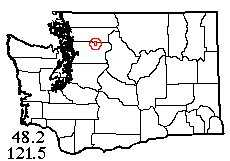 |
![]() 8 X 2009: I hoped to inaugurate fall collecting season with a double-sample day, something I'd managed before when I had another full-fledged collector along. But today, I was collecting alone with my friend Della along as driver. Our first stop was Frog Lake in the national forest southeast of Darrington. It turned out to be a lovely spot with varied habitats, under looming Jumbo Mountain, and exceptionally peaceful; we heard hardly a sound except from a couple of passing airplanes. Unfortunately there wasn't much leaf litter on the side of the lake I reached, and that little wasn't too productive. Moss on the trees had good spiders though, and I got a few species each from hemlock foliage, the lakeside marsh, and forest understory. At first I thought I saw unseasonable wolf spiders dashing in and out of the lakeside mud cracks. It was tiny blackish froglets! Feeling fairly confident that I'd supplemented my previous 2-species sample, we enjoyed Della's delicious picnic lunch and headed for my second goal. Alas, the total here was only 19 species. With luck, maybe someone in Darrington will send me some house spiders.
8 X 2009: I hoped to inaugurate fall collecting season with a double-sample day, something I'd managed before when I had another full-fledged collector along. But today, I was collecting alone with my friend Della along as driver. Our first stop was Frog Lake in the national forest southeast of Darrington. It turned out to be a lovely spot with varied habitats, under looming Jumbo Mountain, and exceptionally peaceful; we heard hardly a sound except from a couple of passing airplanes. Unfortunately there wasn't much leaf litter on the side of the lake I reached, and that little wasn't too productive. Moss on the trees had good spiders though, and I got a few species each from hemlock foliage, the lakeside marsh, and forest understory. At first I thought I saw unseasonable wolf spiders dashing in and out of the lakeside mud cracks. It was tiny blackish froglets! Feeling fairly confident that I'd supplemented my previous 2-species sample, we enjoyed Della's delicious picnic lunch and headed for my second goal. Alas, the total here was only 19 species. With luck, maybe someone in Darrington will send me some house spiders.
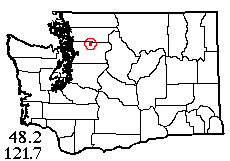 |
![]() For the second half of the day, I'd picked an old abandoned railroad right-of-way that Snohomish County purchased for future trail development. Although not officially a trail yet, it still gets used, even by bicyclists. And turkeys! – a small flock belonging to the farmer next door was feeding right in the middle. I set up for sifting under a maple tree and did considerably better with the litter. Moss on a nearby trunk produced six more species. The neighbor lady looking for her turkeys stopped to chat, and even found me a Metellina segmentata in an aerial web. After Della got tired and went back to the car, I sampled understory foliage (getting the day's highlight, a giant Agelenopsis potteri, in a large funnel web among the herbs); then looked fruitlessly for something among the cobbles along the adjacent Boulder River; found a few under cut wood in a pasture; and swept field grass in the dusk until it was too dark to see the spiders. I love collecting in the dim evening light. But the field sample here was not too diverse, 7 species dominated by the introduced Xysticus cristatus. Still, we ended with 25 species from the area, and another lovely sunset.
For the second half of the day, I'd picked an old abandoned railroad right-of-way that Snohomish County purchased for future trail development. Although not officially a trail yet, it still gets used, even by bicyclists. And turkeys! – a small flock belonging to the farmer next door was feeding right in the middle. I set up for sifting under a maple tree and did considerably better with the litter. Moss on a nearby trunk produced six more species. The neighbor lady looking for her turkeys stopped to chat, and even found me a Metellina segmentata in an aerial web. After Della got tired and went back to the car, I sampled understory foliage (getting the day's highlight, a giant Agelenopsis potteri, in a large funnel web among the herbs); then looked fruitlessly for something among the cobbles along the adjacent Boulder River; found a few under cut wood in a pasture; and swept field grass in the dusk until it was too dark to see the spiders. I love collecting in the dim evening light. But the field sample here was not too diverse, 7 species dominated by the introduced Xysticus cristatus. Still, we ended with 25 species from the area, and another lovely sunset.
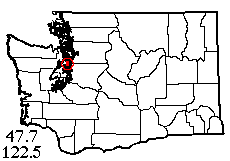 |
![]() 20 X 2009: Delayed a few days by a cold virus and wet weather, I had one good day for my second fall trip before the rains returned. Two public transit systems and a ferry brought me to Kingston, northern Kitsap County. A mile's walk from the ferry terminal was tiny Arness Beach Park, where I hoped to get a few shore species. The morning fog had just lifted, and much of the vegetation was too wet with dew for collecting, but I snared 8 common spider species (none beach-associated) from the foliage and litter of a small protected clump of shrubs and trees. While doing so, my sunglasses found their way from my pocket into the shrub clump. Then on to another site, a small cemetery 1.5 miles walk from the ferry. This was also too dewy for good collecting, but one dry cedar tree brought me up to 10 spider species.
20 X 2009: Delayed a few days by a cold virus and wet weather, I had one good day for my second fall trip before the rains returned. Two public transit systems and a ferry brought me to Kingston, northern Kitsap County. A mile's walk from the ferry terminal was tiny Arness Beach Park, where I hoped to get a few shore species. The morning fog had just lifted, and much of the vegetation was too wet with dew for collecting, but I snared 8 common spider species (none beach-associated) from the foliage and litter of a small protected clump of shrubs and trees. While doing so, my sunglasses found their way from my pocket into the shrub clump. Then on to another site, a small cemetery 1.5 miles walk from the ferry. This was also too dewy for good collecting, but one dry cedar tree brought me up to 10 spider species.
Fortunately, right across the road was a 7.9 acre tract of undeveloped county land full of splendid spider habitats! In one corner was a tiny shed that produced 4 house spider species. Just over half the property was a huge hilly grassy field (with only a little blackberry), too dew-wet to sweep at the moment, but promising. Down the grassy slope (hoping for leaf litter), I found some alders and could see maples in the distance. Much to my surprise, between the two tree stands was an exceptionally high quality cattail marsh! A bit of post-trip geographic research identified this marsh as the headwaters of Grovers Creek, important enough to have a salmon hatchery but still un-named on the clearly not field-checked local topo map. Alder and shrub litter at the marsh edge gave me 12 spider species including something I've wanted for a long time: the unknown male of an undescribed species of Aphileta, plus other good wetland fauna. Maple litter nearby gave me 6 more species. There were a few spiders, but nothing new, in moss hummocks in the marsh. The fauna of young Douglas-firs was rich as always, including bright-colored microspider Walckenaeria auranticeps. I didn't get too many species by sweeping the marsh itself, but those few included the rarely seen Pachygnatha dorothea (a wetland orbweaver that makes no web). Finally, with dusk coming on, the large field was ready to sweep, and added several species despite the dominance of invasive Xysticus cristatus. Walking back to the ferry, I missed my sunglasses, took a detour back to the beach park, and found them! Total for the day, 43 spider and 7 harvestman species. Total financial outlay, under 11 dollars!
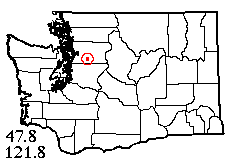 |
![]() 28 X 2009: The weather report gave me one more collecting window before Standard Time gave me one less hour of daylight. Seattle had been dry on Tuesday so I hoped Sultan, and readily accessible Rudolf Reese Park, would be dry on Wednesday. Alas for the vanity of human hopes – it had rained there not many hours before, but at least there was no rain while I was there. Also alas, there was a lot of invasive blackberry here and there. The Sultan River was so high, it was running right through the shore meadow that had really attracted me to the place. And the first leaf litter I sifted was richer in harvestmen, millipeds and isopods than in spiders; while the hemlock litter produced one mature spider. On the plus side, I had a nice picnic shelter to sift in and didn't have to kneel on the soggy ground. There were few people in the park, but every so often a pickup truck (not always the same one) would drive in, park in some out-of-the-way corner, and sit there running its motor for a while before driving out again. People seldom got out. Sometimes human behavior is almost as strange as spider behavior.
28 X 2009: The weather report gave me one more collecting window before Standard Time gave me one less hour of daylight. Seattle had been dry on Tuesday so I hoped Sultan, and readily accessible Rudolf Reese Park, would be dry on Wednesday. Alas for the vanity of human hopes – it had rained there not many hours before, but at least there was no rain while I was there. Also alas, there was a lot of invasive blackberry here and there. The Sultan River was so high, it was running right through the shore meadow that had really attracted me to the place. And the first leaf litter I sifted was richer in harvestmen, millipeds and isopods than in spiders; while the hemlock litter produced one mature spider. On the plus side, I had a nice picnic shelter to sift in and didn't have to kneel on the soggy ground. There were few people in the park, but every so often a pickup truck (not always the same one) would drive in, park in some out-of-the-way corner, and sit there running its motor for a while before driving out again. People seldom got out. Sometimes human behavior is almost as strange as spider behavior.
Taking a break from sifting, I checked the outsides of park buildings (all locked for the season) and added 4 species including Platycryptus californicus, our uncommon house jumping spider, from the baseball dugout. Things really looked better when I started beating hemlock foliage, with just a few trees giving me 13 species. At first I found little moss, but a dead-end trail into the woods ended at a little vine maple grove that was splendidly mossy and the moss, though wet, produced 10 spider species. Across the baseball diamond, at the foot of a slope leading up to a mobile-home "park" was a narrow band of tall grass; by 4:30 it was barely dry enough to sweep. Unexpectedly, part was marshy and I got 13 species including 3 wetland specialists. This field had more diverse spiders than others I'd swept lately, because it was not dominated (yet) by invasive Xysticus cristatus; I only got one. A couple of species were added from maple litter on the slope above the field, as the last daylight ebbed away. After a longish wait for the bus by the busy highway, I was pleasantly surprised to be recognized by a friendly female bus driver who'd last seen me on the Hatt Slough trip exactly 3 years before! As she plied me with spider questions, the rain started to patter, too late to prevent a successful 34-species trip.
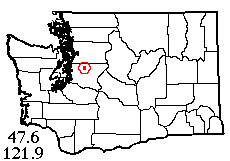 |
![]() 4 XI 2009: An unexpected balmy clear day distinguished the middle of the first week of November. I took a time-consuming three-bus route to the town of Carnation in east King County and walked out to Tolt River John MacDonald Memorial Park (whew!) on the Snoqualmie River just below the Tolt confluence. The large park has enough diverse habitats that 4.5 hours of daylight wasn't enough to visit all of them. On the near side of the river are lawns, buildings and playfields, cottonwood and alder woods, and rather well-hidden wetlands. Across a suspension footbridge is seral forest of diverse types (some invaded by blackberry), a campground, and additional riparian habitats. I started just across the bridge in a cottonwood forest growing on an old sand bar. The litter layer was very thin (resting on sand) but produced 2 spider species not found elsewhere; one was my first male of the rare microspider Porrhomma terrestre! The understory here was too wet and blackberry-invaded for collecting, and isolated Douglas-fir trees had few spiders, so I moved upslope to a secluded camping cabin in the mouth of a ravine, where I set up to sift some good litter. Good litter proved hard to find, but I got some that was OK (9 spider species) from the crotches of some horse chestnut trees that seemed a different species from the one widely planted in Seattle. A small maple tree almost concealed by its load of moss was easy to find, and 2 loads of moss gave me 6 species. The fern understory was reasonably productive, though so loaded with debris that the spiders were rather hard to sort out. In this vicinity, the only low-growing conifers were red cedars, with 5 species on the foliage.
4 XI 2009: An unexpected balmy clear day distinguished the middle of the first week of November. I took a time-consuming three-bus route to the town of Carnation in east King County and walked out to Tolt River John MacDonald Memorial Park (whew!) on the Snoqualmie River just below the Tolt confluence. The large park has enough diverse habitats that 4.5 hours of daylight wasn't enough to visit all of them. On the near side of the river are lawns, buildings and playfields, cottonwood and alder woods, and rather well-hidden wetlands. Across a suspension footbridge is seral forest of diverse types (some invaded by blackberry), a campground, and additional riparian habitats. I started just across the bridge in a cottonwood forest growing on an old sand bar. The litter layer was very thin (resting on sand) but produced 2 spider species not found elsewhere; one was my first male of the rare microspider Porrhomma terrestre! The understory here was too wet and blackberry-invaded for collecting, and isolated Douglas-fir trees had few spiders, so I moved upslope to a secluded camping cabin in the mouth of a ravine, where I set up to sift some good litter. Good litter proved hard to find, but I got some that was OK (9 spider species) from the crotches of some horse chestnut trees that seemed a different species from the one widely planted in Seattle. A small maple tree almost concealed by its load of moss was easy to find, and 2 loads of moss gave me 6 species. The fern understory was reasonably productive, though so loaded with debris that the spiders were rather hard to sort out. In this vicinity, the only low-growing conifers were red cedars, with 5 species on the foliage.
Armed with only a fair sample, I recrossed the river and investigated the large main restroom building. Nothing on the walls but one harvestman and a few flies! With daylight dwindling, my last resource was a large, promising grassy field. Sweepable spiders were surpassingly sparse out in the open field, but in my last half-hour, I located a more diverse area of shorter grasses and herbs that gave me 10 species, including juveniles of our local "fishing spider" Dolomedes triton, which I haven't seen in years! It turns out I was right next to an oxbow pond (that must be high-quality to have this spider) without knowing it. Back at the highway in time to photograph a Carnation-colored sunset, I was soon embarked on the long bus ride home armed with 31 new spider records.
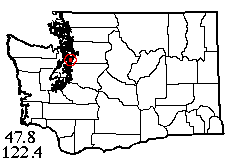 |
![]() 3 XII 2009: For nearly a month since my last time out, it was too wet to collect. Finally, a dry (if somewhat chilly) week! Laurel was unavailable until Friday (when rain was due to resume) so I took another bus and ferry trip to Kingston, this time aiming for the town's northeast quadrant and a tract of public land called Quiet Place Park. It was a pleasant surprise. Instead of a big sign and driveway there was a footpath with a little sign, "Public Trail" with the icon of 2 bare feet! The path led through a completely natural, invasive-free stand of mature Douglas-fir with salal and fern understory; past a partly cut-up windfall log; into a maple grove; a seemingly natural meadow with tall and short grass, bracken, and an extensive wild-rose thicket; then into alder (with a few cascara trees) and more maple before finally re-entering Suburbia. There was only a little blackberry and no ivy at all, even though the meadow was across a fence from a large house. Congratulations to Kitsap County on having such a nice park!
3 XII 2009: For nearly a month since my last time out, it was too wet to collect. Finally, a dry (if somewhat chilly) week! Laurel was unavailable until Friday (when rain was due to resume) so I took another bus and ferry trip to Kingston, this time aiming for the town's northeast quadrant and a tract of public land called Quiet Place Park. It was a pleasant surprise. Instead of a big sign and driveway there was a footpath with a little sign, "Public Trail" with the icon of 2 bare feet! The path led through a completely natural, invasive-free stand of mature Douglas-fir with salal and fern understory; past a partly cut-up windfall log; into a maple grove; a seemingly natural meadow with tall and short grass, bracken, and an extensive wild-rose thicket; then into alder (with a few cascara trees) and more maple before finally re-entering Suburbia. There was only a little blackberry and no ivy at all, even though the meadow was across a fence from a large house. Congratulations to Kitsap County on having such a nice park!
I knew the trip was a success as soon as I saw how teeming the maple-fir litter was. Less than 2 hours of sifting gave me 17 spider species (though the alder-cascara litter added little). Fir and lodgepole-pine foliage, understory foliage, sparse and scanty moss on a few trees, and grass-sweeping in the meadow added a few species each for a total of 31. From 11 AM until after 3 PM, there was no sign of a fellow human; then distant voices heralded the approach of two young ladies walking their dogs. The one who stopped to chat had to have the word "fauna" explained to her. When she understood what I was doing, she said "Isn't that interesting?" Her friend replied "No." By 4:00, the temperature (not too cold at midday) had dropped enough that sifted spiders refused to move, so I headed back toward the ferry in time to catch another sunset photo for the album. Just about time for winter dormancy, but weather permitting, I hope for at least one more field day this year…
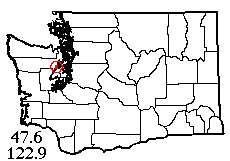 |
![]() 24 XII 2009: It was either too wet or too cold most of this month. Finally, Laurel and I lacking plans for Christmas Eve, we planned a trip to a pair of interesting sites on the east slope of the Olympic Peninsula. The road that (on maps and photos) gives easy access to the first site was gated and posted private. The second site (Bull Elk Canyon) is on the main Forest Service road up the Dosewallips River, which surely wouldn't be closed, but it was. The sign and web site say the road is closed at 10 miles - it's more like 6! Stymied, I searched my maps for an alternate area and selected the Duckabush River (next stream to the south) where I had a 3-species prior sample from the salt marsh at the mouth. We drove up the Duckabush Road as far as Interrorem Guard Station, oldest Forest Service building on the Olympic Peninsula (the reason for the odd name seems to be lost in the mists of time). The surroundings, well-developed mature second growth hemlock, approach the true rain forest in their mossiness. So (after finding nothing in the historic building), I sifted moss (6 species) while Laurel sought out and found some dry conifer foliage (3 species, including the day's supreme record, Wubana suprema). Leaf litter here was too wet and cold to sift (it had evidently rained here, though dry everywhere else!) so I brought a big bagful back for the Berlese funnel (10 species, after a week's delay).
24 XII 2009: It was either too wet or too cold most of this month. Finally, Laurel and I lacking plans for Christmas Eve, we planned a trip to a pair of interesting sites on the east slope of the Olympic Peninsula. The road that (on maps and photos) gives easy access to the first site was gated and posted private. The second site (Bull Elk Canyon) is on the main Forest Service road up the Dosewallips River, which surely wouldn't be closed, but it was. The sign and web site say the road is closed at 10 miles - it's more like 6! Stymied, I searched my maps for an alternate area and selected the Duckabush River (next stream to the south) where I had a 3-species prior sample from the salt marsh at the mouth. We drove up the Duckabush Road as far as Interrorem Guard Station, oldest Forest Service building on the Olympic Peninsula (the reason for the odd name seems to be lost in the mists of time). The surroundings, well-developed mature second growth hemlock, approach the true rain forest in their mossiness. So (after finding nothing in the historic building), I sifted moss (6 species) while Laurel sought out and found some dry conifer foliage (3 species, including the day's supreme record, Wubana suprema). Leaf litter here was too wet and cold to sift (it had evidently rained here, though dry everywhere else!) so I brought a big bagful back for the Berlese funnel (10 species, after a week's delay).
Next stop was an unusually extensive powerline clearing Laurel had spotted on the way in. Even at 40°F, the sun had dried enough vegetation in the open that she was able to get decent sweep samples from grass, Scots broom (of all things), and Rhododendron. There were very few spiders on conifer foliage here. Meanwhile, I sifted a number of additional species from maple and alder litter warmed by that same sunlight. I had just got going on sifting moss when the sun went behind the ridge, and fog started to form. Suddenly it was too cold for any spiders to move. Must be winter! But the prior records plus our field collecting brought the area sample to 23 species; the final total with Berlese funnel sample was 30.
That wraps up 2009. Stay tuned for 2010!
This page last updated 21 March, 2025